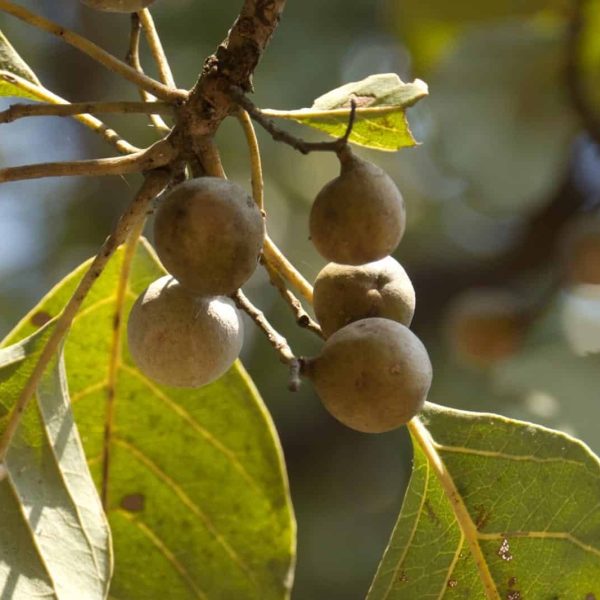-
How does it feel?
Bibhitaki is a large deciduous tree native to Indian forests and plains, growing up to 20 metres in height. It has a distinctive thick, dark green bark and a large crown canopy. Leaves are often clustered towards the ends of branches and the flowers are a greenish/yellow colouring arranged in spikes and produce a distinctive and often unpleasant odour. The fruits of this plant, which is the portion used medicinally, are green when young and then turn a yellow colour and become slightly ribbed to touch when they are mature.
-
What can I use it for?
Bibhitaki is a naturally strong astringent, tonifying mucous membranes throughout the body, with a particularly strong effect within the digestive tract, improving peristaltic motion. It has also demonstrated the ability to reduce lipid volume in the blood stream, impacting upon blood cholesterol levels and heart health. Bibhitaki contains a small portion of cardiac glycosides which, alongside its ability to reduce lipid congestion, protect the functioning of the heart.
-
Into the heart of bibhitaki

Bibhitaki is a potent astringent and tonifying herb for the body’s mucous membranes. The astringent qualities of this plant make it effective at drying and removing excessive levels of congestive mucous or fluid build-up present within the body. It has a particular affinity for the digestive tract, being part of the famous Ayurvedic formula for the digestion known as Triphala. It encourages strength and tone within the digestive system, and improves digestive motion and efficiency. It’s strengthening and toning activity within the body extends to the nervous system, strengthening it during periods of excessive stress. It also strengthens and tones mucous membranes within the respiratory system, protecting it from chronic congestive mucous build up.
Asthma, bronchitis, cough, laryngitis and where there is copious, white or clear phlegm, Bibhitaki can help to clear and dry this congestion.Also used to soothe a sore throat when mixed with honey and also used as a gargle.
It has a particular affinity for the upper body and head. It clears congestion from the eyes, ears, nose and throat. Also indicated for helping to maintain hair growth.
Diarrhoea, colitis, Crohn’s disease, intestinal inflammation and parasites. It has a dual action of being both astringent and laxative that helps to increase peristalsis as well as strengthen the mucus membranes of the colon. The unripe fruits have a stronger laxative action and the ripe fruits are more astringent.
Bladder stones, cloudy urine through its ability to clear mucous congestion and/or congestion caused by infection.
Insomnia; its astringent nature can strengthen irritated and sensitive nerves of the head.
Its cardiac glycoside content and ability to reduce stagnant congestion indicate its use for cardiac congestion and insufficiency.
-
Traditional actions
Herbal actions describe therapeutic changes that occur in the body in response to taking a herb. These actions are used to express how a herb physiologically influences cells, tissues, organs or systems. Clinical observations are traditionally what have defined these actions: an increase in urine output, diuretic; improved wound healing, vulnerary; or a reduction in fever, antipyretic. These descriptors too have become a means to group herbs by their effects on the body — herbs with a nervine action have become the nervines, herbs with a bitter action are the bitters. Recognising herbs as members of these groups provides a preliminary familiarity with their mechanisms from which to then develop an understanding of their affinities and nuance and discern their clinical significance.
-
Traditional energetic actions
Herbal energetics are the descriptions Herbalists have given to plants, mushrooms, lichens, foods, and some minerals based on the direct experience of how they taste, feel, and work in the body. All traditional health systems use these principles to explain how the environment we live in and absorb, impacts our health. Find out more about traditional energetic actions in our article “An introduction to herbal energetics“.
Western energetics
-
Did you know?
The seeds of this plant are 40% oil and are often harvested for use as a biodiesel. The bibhitaki fruits are also a key ingredient in the famous Ayurvedic combination known as Triphala.
Additional information
-
Safety
No safety issues of concern.
-
Dosage
Tincture: 3–15ml of a (1:3, 25%)
Dried: 250mg–3g/day


































